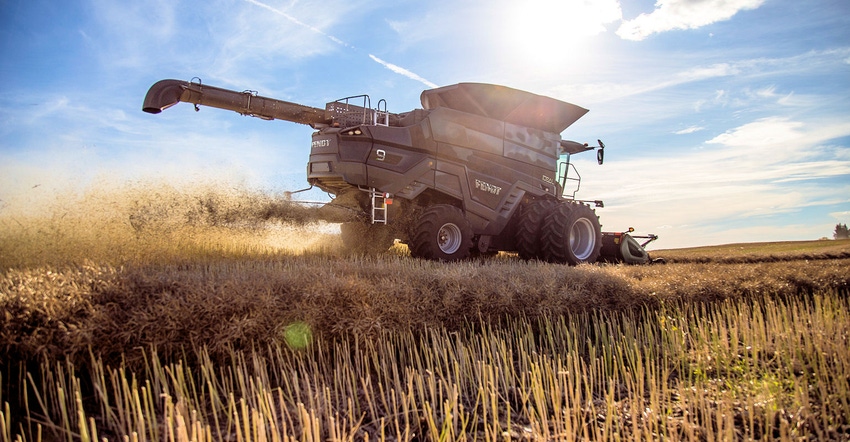June 27, 2018

The rollout of a new black combine by Agco during Agritechnica last year and for North America recently, is just the latest salvo in the world of harvest technology. The Fendt Ideal combine has a distinctive look and the company claims it is the first 'clean sheet' design of a combine in 30 years. Yet, Agco isn't the only company ramping up harvest tech.
The Ideal combine brings new energy to the harvest equipment market as the company talks about the threshing system and tech offered. The dual-rotor system (single rotor on the Class 7 machine) will be new, though New Holland has had a dual rotor system in the market for decades.
That's just fodder for marketers and dealers as farmers look at harvest machines. The growing issue is the tech inside these harvesters not only of crops but of data. And, the ways that these machines use sensors and tech to work will become a key selling point. The Ideal combine offers new ways to "visualize" what's going on inside your combine, and for those of you who like control it's there; for less experienced operators the new machine maintains proper harvest accuracy automatically.
What's inside
Last year, John Deere introduced the S700 series combines, which didn't look much different on the outside from the S600, but were in fact quite a bit different on the inside. The level of tech for both on-board calibration for accurate yield monitoring; and the use of tech to manage harvested crop quality under changing conditions included use of new kinds of sensors and tech.
The folks at Claas have been marketing the Lexion and its got a range of upgraded technology including the ability to change systems on the go to maximize harvested grain quality. The sensors and tools involved with that machine would surprise many farmers.
Case IH has been upgrading systems - or the "guts" - of its machines to boost efficiency. The use of continuously variable transmissions on key drive points has simplified the innards, reduced service points and belts too. The company has also upgraded tech for collecting yield data and combined with the company's AFS system, allows farmers a range of tech access.
New Holland has also been advancing combine tech and efficiency. It's two-rotor design has long been a hallmark of those big yellow machines. And the company has worked to boost efficiency and "go bigger" with larger class machines.
Rethinking harvest
And I’m just looking at the combines themselves, innovations to corn heads and stripper heads that are boosting crop harvesting efficiency.
We've even seen a new way of thinking about harvesting, moving beyond the 'combine' to create a new approach where combine and grain wagon become one. The Tribine harvester continues to garner attention at farm shows (as it will in Boone for Farm Progress Show and Grand Island for Husker Harvest Days).
This machine is a kind of "think different" tool that is being refined. The company is running demonstrations across the country this season. The idea of a single machine doing that work is intriguing to mid-size farmers with labor issues. A conversation I had with one farmer on the idea opened my eyes into ways that machine would work beyond what a traditional combine and grain cart setup does today.
As readers turn toward #harvest18 this year, a serious look at the tools you're using will be in order. If your combine is more than five years old - and many have put of major purchases - getting to know the latest tech advancements for these machines will help your buying decision.
A farm show is a great place to start to learn (full disclosure, Farm Progress owns two farm shows). And this year it appears there will be plenty of harvest tech to review.
About the Author(s)
You May Also Like






